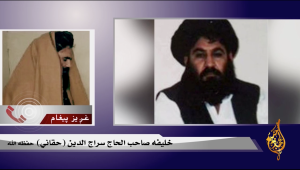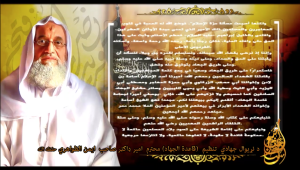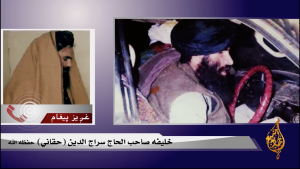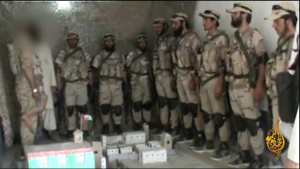An audio clip of Siraj Haqqani (left) swearing allegiance to the Taliban’s new emir, Mullah Akhtar Mohammad Mansour (right), is included in a new Taliban video.
In late August, the Taliban released the fifth installment in its “Army of Badr” video series. The title of the videos is a reference to the battle of Badr in 624 CE between the Prophet Mohammed’s followers and their enemies. The battle is considered a crucial event in early Islamic history. And in the Taliban’s attempt to portray its own jihad as part of this history, two senior jihadists are especially conspicuous: Ayman al Zawahiri and Siraj Haqqani.
Approximately 16 minutes into the video, the Taliban replays Zawahiri’s audio message from August in which he offers his condolences for the death of Mullah Omar and pledges his allegiance to the Taliban’s new emir, Mullah Akhtar Mohammad Mansour.
The recording, along with the image of Zawahiri (see on the right), was first released by al Qaeda on August 13. It was recorded on August 1, just two days after the Taliban confirmed Omar’s death. On August 14, one day after Zawahiri’s oath was released, Mullah Mansour publicly accepted it, praising the “esteemed” al Qaeda leader in the process.
The Taliban has inserted text at the bottom of the image of Zawahiri. The sentence reads: “The leader of the international jihadist organization of al Qaeda, the respected emir Dr. Ayman al Zawahiri, May God Protect Him.”
Mansour’s public acceptance of Zawahiri’s oath and open endorsement of al Qaeda has, comparatively speaking, received scant attention. But it is a strong indication that the Taliban and al Qaeda remain closely allied 14 years after the September 11, 2001 terrorist attacks. At a time when many in the West have written off Zawahiri’s organization, the Taliban is loudly broadcasting al Qaeda’s enduring influence.
Siraj Haqqani, who leads the network established by his father, Jalaluddin, has been appointed as one of Mansour’s two top deputies. As The Long War Journal has reported, files recovered in Osama bin Laden’s compound and much other evidence demonstrates that Siraj is closely allied with al Qaeda. [See LWJ report, The Taliban’s new leadership is allied with al Qaeda.]
The Taliban’s “Army of Badr” video includes a lengthy audio statement from Siraj. A still image of Siraj is shown alongside photos of Mullah Omar and others as he speaks. A screen shot of one of these pairings can be seen on the right. Siraj is shown on the left, with Mullah Omar on the right in the image.
Siraj does not mention when Omar died, but says his death was a “great catastrophe” for Muslims around the world. Still, Siraj says, the jihadists believe in Allah’s “fate” and “predestination.” Thus, they accept Omar’s death and will fight on.
He emphasizes that Omar’s successor, Mullah Mansour, was chosen by a “consensus” of all the recognized jihadist authorities in the region.
“I have pledged allegiance directly on my behalf and indirectly on behalf of all our mujahidin to the Commander of the Faithful, Mullah Akhtar Mohammad Mansour, my Allah protect him,” Siraj says, according to a translation obtained by The Long War Journal. Siraj’s statement indicates, therefore, that he is swearing fealty to Mullah Mansour on behalf of all of the jihadists in the Haqqani Network. And he goes on to call for the entire worldwide community of Muslims, “all the mujahidin” and especially all “the mujahidin of Afghanistan” to follow and obey “the new Commander of the Faithful, Mullah Akhtar Mohammad Mansour,” just as they obeyed his predecessor, Mullah Omar.
Siraj praises Mansour, saying he “served” the Taliban’s “Islamic Emirate with great sincerity” as its “deputy and guardian” for the past few years. Mansour “has led the current jihad against the crusaders’ occupation until now, with utmost sincerity and honesty,” Siraj says. He warns against internal divisions, saying the media seeks to sow discord in the jihadists’s ranks. But the Haqqani Network leader claims the Taliban is united behind its new leader and “there are no worrisome differences.”
The “mujahidin of the [Taliban’s] Islamic Emirate” are in “control” of “many freed areas” and “manage all of their jihadist efforts from those freed areas,” Siraj says. “Their command centers are inside Afghanistan.” Siraj’s words are likely intended to deflect the allegation, which has been true for years, that the Taliban-led insurgency is actually headquartered inside Pakistan.
The Taliban’s video is clearly intended to demonstrate a united front in the wake of Mullah Omar’s controversial death, which Omar’s comrades admittedly covered up. In that vein, the propaganda production includes numerous scenes of the Taliban’s rank and file affirming their fealty to Mullah Mansour.
For instance, three “directors” of the Taliban’s operations in various provinces pledge their loyalty to Mullah Mansour in audio clips included in the video. They are: Al Hajj Mullah Abdul Manan (the Taliban’s “director” in Helmand), Hafez Muhebullah (“director” of the Kabul province), and Qari Salahuddin (who led the Taliban in the northern Faryab province). Each of these “directors” serves as a Taliban “shadow governor” in his designated province. Qari Salahuddin was recently captured by Afghanistan’s intelligence service as he was reportedly attempting to travel to Pakistan.
The video highlights two other commanders who remain loyal to the Taliban’s leadership as well. Both direct the Taliban’s suicide operations. One is Mullah Taj Mir Jawad, who is described as the head of the Taliban’s martyrdom-seekers battalion. The other is Qari Abdul Raouf Zakir, who is listed as the “commander” of the Taliban’s “suicide groups.”
Qari Zakir, who was designated as a terrorist by the State Department in November 2012, has long headed the Haqqani Network’s suicide operations. The inclusion of him in the video further underscores the high degree of integration between the Haqqanis and the Taliban.
Much of the video is dedicated to the Taliban’s suicide operations. A number of suicide bombers give short speeches explaining why they decided to become “martyrdom” operatives in the first place.
A significant chunk of the 95-minute production is devoted to the planning and execution of a massive operation utilizing these “martyrs” in the Ghazni province. In one scene, approximately eight uniformed Taliban fighters, including a few who have volunteered to detonate massive improvised vehicle bombs, are shown standing around crude models of government buildings. A screen shot of this footage can be seen on the right.
A trainer, whose face is deliberately obscured, explains how each of his men will attack the buildings. “There are no civilians here,” he claims. “You are shooting only government employees.” The Taliban has been widely criticized, including by the United Nations, for its indiscriminate killing of civilians. The trainer’s words are probably intended to emphasize the Taliban’s targeting of Afghan government forces. The operation is carried out and the Taliban includes snippets of local news reports highlighting its devastation.
The video closes with images of smiling and laughing suicide bombers, one of whom proudly shows off his explosives vest.
While the production is propaganda and intended to glorify the jihad in Afghanistan, it is still an unfortunate reminder that the jihadist “syndicate” continues to threaten Afghanistan long after the US-led invasion in late 2001.












3 Comments
so the Public Relations battle rages on. How this resonant’s with the rank & file obviously continues to bedevil the Taliban’s hierarchy & Allies. The fact that they continue to emphasis it is evidence that they are seriously concerned with its present course & whatever future courses will surface because of it. Undoubtedly their chief benefactor, that cell of Islamist’s within Pakistan’s ISI, has already begun hedging their ‘bets’ & found ways to quietly establish contact with those elements of the AfPak Insurgency at odds with the Taliban & their Allies. Pakistan’s ISI played the same musical chair game during the rise of the Taliban in the 90’s & with the Mujahideen during the 80’s. Sidelining those they lost confidence in, Gulbuddin Hekmatyar for example, & supporting those they felt best served their own interests. This contest of wills is far from being resolved
I really learn a lot from these analyses. However, I would like to see a more neutral language used. Muhammad is referred to as “Prophet Mohammed”. It should of course be “the Muslim prophet Muhammad”. Further down Allah, the god of Muslims is translated wrongly as “God”. “Illah” is god in Arabic and “Allah” is the name of the Muslim god.
I think these are not petty grammatical issues but important ideological issues. There is no neutral language, but the author supports the jihadi narrative by preceding Muhammad with the unqualified honorific “Prophet” and equating Allah with the Judeo-Christian God.
The Taliban realize that we went to Afghanistan primarily to fight AQ and deny them a safe haven to plan attacks from. In announcing their allegiance, it sounds to me like they are asking for continued American military presence in Afghanistan. It could be that they just love having western foreigners to fight.